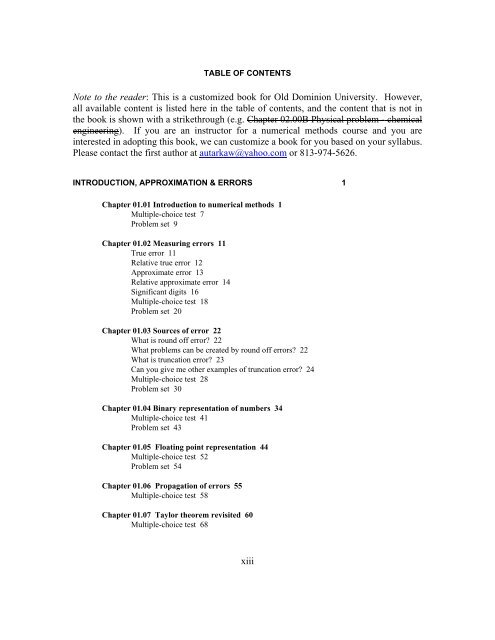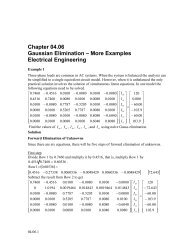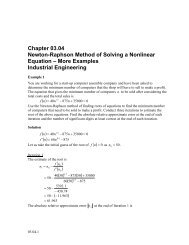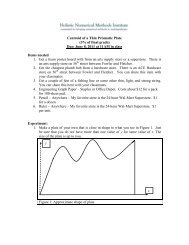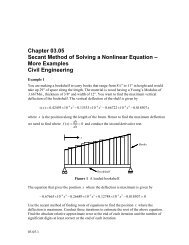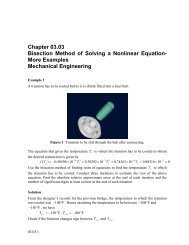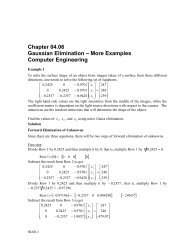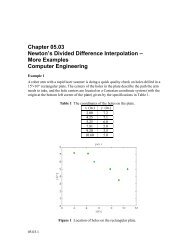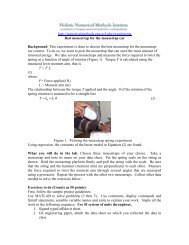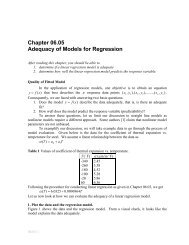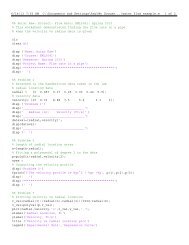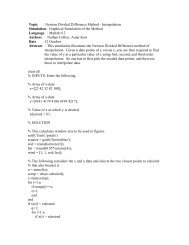xiii Note to the reader: This is a customized book for Old Dominion ...
xiii Note to the reader: This is a customized book for Old Dominion ...
xiii Note to the reader: This is a customized book for Old Dominion ...
Create successful ePaper yourself
Turn your PDF publications into a flip-book with our unique Google optimized e-Paper software.
TABLE OF CONTENTS<strong>Note</strong> <strong>to</strong> <strong>the</strong> <strong>reader</strong>: <strong>Th<strong>is</strong></strong> <strong>is</strong> a cus<strong>to</strong>mized <strong>book</strong> <strong>for</strong> <strong>Old</strong> <strong>Dominion</strong> University. However,all available content <strong>is</strong> l<strong>is</strong>ted here in <strong>the</strong> table of contents, and <strong>the</strong> content that <strong>is</strong> not in<strong>the</strong> <strong>book</strong> <strong>is</strong> shown with a strikethrough (e.g. Chapter 02.00B Physical problem - chemicalengineering). If you are an instruc<strong>to</strong>r <strong>for</strong> a numerical methods course and you areinterested in adopting th<strong>is</strong> <strong>book</strong>, we can cus<strong>to</strong>mize a <strong>book</strong> <strong>for</strong> you based on your syllabus.Please contact <strong>the</strong> first author at autarkaw@yahoo.com or 813-974-5626.INTRODUCTION, APPROXIMATION & ERRORS 1Chapter 01.01 Introduction <strong>to</strong> numerical methods 1Multiple-choice test 7Problem set 9Chapter 01.02 Measuring errors 11True error 11Relative true error 12Approximate error 13Relative approximate error 14Significant digits 16Multiple-choice test 18Problem set 20Chapter 01.03 Sources of error 22What <strong>is</strong> round off error? 22What problems can be created by round off errors? 22What <strong>is</strong> truncation error? 23Can you give me o<strong>the</strong>r examples of truncation error? 24Multiple-choice test 28Problem set 30Chapter 01.04 Binary representation of numbers 34Multiple-choice test 41Problem set 43Chapter 01.05 Floating point representation 44Multiple-choice test 52Problem set 54Chapter 01.06 Propagation of errors 55Multiple-choice test 58Chapter 01.07 Taylor <strong>the</strong>orem rev<strong>is</strong>ited 60Multiple-choice test 68<strong>xiii</strong>
DIFFERENTIATION 70Physical problemsChapter 02.00A Physical problem - general engineering 70Chapter 02.00B Physical problem - chemical engineeringChapter 02.00C Physical problem – civil engineering 72Chapter 02.00D Physical problem - computer engineeringChapter 02.00E Physical problem - electrical engineeringChapter 02.00F Physical problem - industrial engineeringChapter 02.00G Physical problem - mechanical engineering 76Chapter 02.01 Primer on differential calculus (View it on <strong>the</strong> web)Go <strong>to</strong> http://numericalmethods.eng.usf.edu>Keyword> Primer on differential calculusMultiple-choice test 80Problem set 82Chapter 02.02 Differentiation of continuous functions 84Forward difference approximation of <strong>the</strong> first derivative 84Backward difference approximation of <strong>the</strong> first derivative 87Forward difference approximation from <strong>the</strong> Taylor series 89Finite difference approximation of higher derivatives 92Multiple-choice test 97Problem set 99Chapter 02.03 Differentiation of d<strong>is</strong>crete functions 101Forward difference approximation of <strong>the</strong> first derivative 101Direct fit polynomials 103Lagrange polynomial 105Multiple-choice test 108Problem set 110xiv
NONLINEAR EQUATIONS 112Physical problemsChapter 03.00A Physical problem - general engineering 112Chapter 03.00B Physical problem - chemical engineeringChapter 03.00C Physical problem - civil engineering 116Chapter 0.3.00D Physical problem - computer engineeringChapter 03.00E Physical problem - electrical engineeringChapter 03.00F Physical problem – industrial engineeringChapter 03.00G Physical problem - mechanical engineering 122Chapter 03.01 Solution of quadratic equations 126Multiple-choice test 129Problem set 131Chapter 03.03 B<strong>is</strong>ection method of solving a nonlinear equation 133B<strong>is</strong>ection method 133Algorithm <strong>for</strong> <strong>the</strong> b<strong>is</strong>ection method 136Advantages of b<strong>is</strong>ection method 139Drawbacks of b<strong>is</strong>ection method 140Multiple-choice test 142Problem set 144Chapter 03.04 New<strong>to</strong>n-Raphson method of solving a nonlinear equation 146Introduction 146Derivation 146Algorithm 147Drawbacks of <strong>the</strong> New<strong>to</strong>n-Raphson method 150What <strong>is</strong> an inflection point? 154Derivation of New<strong>to</strong>n Raphson method from Taylor series 154Multiple-choice test 156Problem set 158Chapter 03.05 Secant method of solving nonlinear equations 160What <strong>is</strong> <strong>the</strong> secant method and why would I want <strong>to</strong> use it instead of <strong>the</strong> New<strong>to</strong>n-Raphson method? 160Multiple-choice test 165Problem set 167Chapter 03.06 False-Position method of solving a nonlinear equation 169Introduction 169False-Position method 170Step-by-step False-Position algorithms 170Multiple-choice test 175xv
SIMULTANEOUS LINEAR EQUATIONS 179Physical problemsChapter 04.00A Physical problem - general engineering 179Chapter 04.00B Physical problem - chemical engineeringChapter 04.00C Physical problem - civil engineering 182Chapter 04.00D Physical problem - computer engineeringChapter 04.00E Physical problem - electrical engineeringChapter 04.00F Physical problem – industrial engineeringChapter 04.00G Physical problem - mechanical engineering 187Chapter 4.1 Introduction <strong>to</strong> matrix algebra 193What does a matrix look like?What <strong>is</strong> a matrix? 193What are <strong>the</strong> special types of matrices? 194Square matrix 195Upper triangular matrix 195Lower triangular matrix 195Diagonal matrix 196Identity matrix 196Zero matrix 196Tridiagonal matrices 197When are two matrices considered <strong>to</strong> be equal? 197How do you add two matrices? 198How do you subtract two matrices? 199How do I multiply two matrices? 200What <strong>is</strong> a scalar product of a constant and a matrix? 202What <strong>is</strong> a linear combination of matrices? 203What are some of <strong>the</strong> rules of binary matrix operations? 203Transpose of a matrix 205Symmetric matrix 206Matrix algebra <strong>is</strong> used <strong>for</strong> solving system of equations. Can you illustrate th<strong>is</strong> concept?206Can you divide two matrices? 208Can I use <strong>the</strong> concept of <strong>the</strong> inverse of a matrix <strong>to</strong> find <strong>the</strong> solution of a set of equations[A] [X] = [C]? 209How do I find <strong>the</strong> inverse of a matrix? 209If <strong>the</strong> inverse of a square matrix [A] ex<strong>is</strong>ts, <strong>is</strong> it unique? 212Multiple-choice test 214Problem set 216Chapter 04.02 Vec<strong>to</strong>rsWhat <strong>is</strong> a vec<strong>to</strong>r?When are two vec<strong>to</strong>rs equal?How do you add two vec<strong>to</strong>rs?What <strong>is</strong> a null vec<strong>to</strong>r?What <strong>is</strong> a unit vec<strong>to</strong>r?How do you multiply a vec<strong>to</strong>r by a scalar?What do you mean by a linear combination of vec<strong>to</strong>rs?What do you mean by vec<strong>to</strong>rs being linearly independent?xvi
What do you mean by <strong>the</strong> rank of a set of vec<strong>to</strong>rs?Prove that if a set of vec<strong>to</strong>rs contains <strong>the</strong> null vec<strong>to</strong>r, <strong>the</strong> set of vec<strong>to</strong>rs <strong>is</strong> linearlydependent.Prove that if a set of vec<strong>to</strong>rs are linearly independent, <strong>the</strong>n a subset of <strong>the</strong> m vec<strong>to</strong>rs alsohas <strong>to</strong> be linearly independent.Prove that if a set of vec<strong>to</strong>rs <strong>is</strong> linearly dependent, <strong>the</strong>n at least one of <strong>the</strong> vec<strong>to</strong>rs can bewritten as a linear combination of o<strong>the</strong>rs.Prove that if <strong>the</strong> dimension of a set of vec<strong>to</strong>rs <strong>is</strong> less than <strong>the</strong> number of vec<strong>to</strong>rs in <strong>the</strong> set,<strong>the</strong>n <strong>the</strong> set of vec<strong>to</strong>rs <strong>is</strong> linearly dependentHow can vec<strong>to</strong>rs be used <strong>to</strong> write simultaneous linear equations?What <strong>is</strong> <strong>the</strong> definition of <strong>the</strong> dot product of two vec<strong>to</strong>rs?Chapter 04.03 Binary matrix operationsHow do you add two matrices?How do you subtract two matrices?How do I multiply two matrices?What <strong>is</strong> a scalar product of a constant and a matrix?What <strong>is</strong> a linear combination of matrices?What are some of <strong>the</strong> rules of binary matrix operations?Commutative law of additionAssociative law of additionAssociative law of multiplicationD<strong>is</strong>tributive lawIs [A][B] = [B][A]?Chapter 04.04 Unary matrix operationsWhat <strong>is</strong> <strong>the</strong> transpose of a matrix?What <strong>is</strong> a symmetric matrix?What <strong>is</strong> a skew-symmetric matrix?What <strong>is</strong> <strong>the</strong> trace of a matrix?Define <strong>the</strong> determinant of a matrix.Is <strong>the</strong>re a relationship between det(AB), and det(A) and det(B)?Are <strong>the</strong>re some o<strong>the</strong>r <strong>the</strong>orems that are important in finding <strong>the</strong> determinant?Chapter 04.05 System of equationsMatrix algebra <strong>is</strong> used <strong>for</strong> solving systems of equations. Can you illustrate th<strong>is</strong> concept?A system of equations can be cons<strong>is</strong>tent or incons<strong>is</strong>tent. What does that mean?How can one d<strong>is</strong>tingu<strong>is</strong>h between a cons<strong>is</strong>tent and incons<strong>is</strong>tent system of equations?If a solution ex<strong>is</strong>ts, how do we know whe<strong>the</strong>r it <strong>is</strong> unique?If we have more equations than unknowns in [A] [X] = [C], does it mean <strong>the</strong> system <strong>is</strong>incons<strong>is</strong>tent?Can I use <strong>the</strong> concept of <strong>the</strong> inverse of a matrix <strong>to</strong> find <strong>the</strong> solution of a set of equations[A] [X] = [C]?How do I find <strong>the</strong> inverse of a matrix?Is <strong>the</strong>re ano<strong>the</strong>r way <strong>to</strong> find <strong>the</strong> inverse of a matrix?If <strong>the</strong> inverse of a square matrix [A] ex<strong>is</strong>ts, <strong>is</strong> it unique?Chapter 04.06 Gaussian elimination 220How are a set of equations solved numerically? 220Forward elimination of unknowns 220Back substitution 222xvii
Are <strong>the</strong>re any pitfalls of Naïve Gauss elimination method? 228Round-off error 229What are <strong>the</strong> techniques <strong>for</strong> improving Naïve Gauss elimination method? 231How does Gaussian elimination with partial pivoting differ from Naïve Gausselimination? 232Can we use Naïve Gauss elimination methods <strong>to</strong> find <strong>the</strong> determinant of a square matrix?235What if I cannot find <strong>the</strong> determinant of <strong>the</strong> matrix using Naive Gauss eliminationmethod, <strong>for</strong> example, if I get div<strong>is</strong>ion by zero problems during Naïve Gauss eliminationmethod? 236Multiple-choice test 238Problem set 241Chapter 04.07 LU decomposition 243I hear about LU decomposition used as a method <strong>to</strong> solve a set of simultaneous linearequations? What <strong>is</strong> it? 243How do I decompose a non-singular matrix [A], that <strong>is</strong>, how do I find A LU?246How do I find <strong>the</strong> inverse of a square matrix using LU decomposition? 250Multiple-choice test 253Problem set 257Chapter 04.08 Gauss-Seidel method 259Why do we need ano<strong>the</strong>r method <strong>to</strong> solve a set of simultaneous linear equations? 259The above system of equations does not seem <strong>to</strong> converge. Why? 264Multiple-choice test 269Problem set 373Chapter 04.09 Adequacy of solutionsWhat does it mean by ill conditioned and well-conditioned system of equations?So what if <strong>the</strong> system of equations <strong>is</strong> ill conditioning or well conditioning?To calculate condition number of an invertible square matrix, I need <strong>to</strong> know what normof a matrix means. How <strong>is</strong> <strong>the</strong> norm of a matrix defined?How <strong>is</strong> norm related <strong>to</strong> <strong>the</strong> conditioning of <strong>the</strong> matrix?What are some of <strong>the</strong> properties of norms?ProofHow do I use <strong>the</strong> above <strong>the</strong>orems <strong>to</strong> find how many significant digits are correct in mysolution vec<strong>to</strong>r?Chapter 04.10 Eigenvalues and eigenvec<strong>to</strong>rsWhat does eigenvalue mean?Can you give me a physical example application of eigenvalues and eigenvec<strong>to</strong>rs?What <strong>is</strong> <strong>the</strong> general definition of eigenvalues and eigenvec<strong>to</strong>rs of a square matrix?How do I find eigenvalues of a square matrix?What are some of <strong>the</strong> <strong>the</strong>orems of eigenvalues and eigenvec<strong>to</strong>rs?How does one find eigenvalues and eigenvec<strong>to</strong>rs numerically?Chapter 04.11 Cholesky and LDL T Decomposition 274Symmetrical positive definite (SPD) SLE 274Re-ordering algorithms <strong>for</strong> minimizing fill-in terms [1,2] 287xviii
On-line chess-like game <strong>for</strong> reordering/fac<strong>to</strong>rized phase 289Multiple-choice test 292xix
INTERPOLATION 300Physical problemsChapter 05.00A Physical problem - general engineering 300Chapter 05.00B Physical problem - chemical engineeringChapter 05.00C Physical problem - civil engineering 302Chapter 05.00D Physical problem - computer engineeringChapter 05.00E Physical problem - electrical engineeringChapter 05.00F Physical problem - industrial engineeringChapter 05.00G Physical problem - mechanical engineering 305Chapter 05.01 Background of interpolationMultiple-choice test 309Chapter 05.02 Direct method of interpolation 311What <strong>is</strong> interpolation? 311Direct method 312Multiple-choice test 320Problem set 322Chapter 05.03 New<strong>to</strong>n’s divided difference interpolation 324What <strong>is</strong> interpolation? 324New<strong>to</strong>n’s divided difference polynomial method 324Linear interpolation 325Quadratic interpolation 327General <strong>for</strong>m of New<strong>to</strong>n’s divided difference polynomial 330Multiple-choice test 335Problem set 337Chapter 05.05 Spline method of interpolationWhat <strong>is</strong> interpolation?Linear spline interpolationQuadratic splinesMultiple-choice testProblem setChapter 05.06 Extrapolation <strong>is</strong> a bad ideaChapter 05.07 Higher order interpolation <strong>is</strong> a bad ideaChapter 05.08 Why do we need splines?Chapter 05.10 Shortest path of a robotxx
REGRESSION 339Physical problemsChapter 06.00A Physical problem - general engineering 339Chapter 06.00B Physical problem - chemical engineeringChapter 06.00C Physical problem - civil engineering 343Chapter 06.00D Physical problem - computer engineeringChapter 06.00E Physical problem - electrical engineeringChapter 06.00F Physical problem - industrial engineeringChapter 06.00G Physical problem - mechanical engineering 346Chapter 06.01 Stat<strong>is</strong>tics background of regression analys<strong>is</strong> 351Review of stat<strong>is</strong>tical terminologies 351Elementary stat<strong>is</strong>tics 351A brief h<strong>is</strong><strong>to</strong>ry of regression 355Multiple-choice test 359Chapter 06.02 Introduction of regression analys<strong>is</strong> 359What <strong>is</strong> regression analys<strong>is</strong>? 359Compar<strong>is</strong>on of regression and correlation 360Uses of regression analys<strong>is</strong> 360Abuses of regression analys<strong>is</strong> 360Extrapolation 361Least squares methods 363Why minimize <strong>the</strong> sum of <strong>the</strong> square of <strong>the</strong> residuals? 363Multiple-choice testProblem set 365Chapter 06.03 Linear regression 366Why minimize <strong>the</strong> sum of <strong>the</strong> square of <strong>the</strong> residuals? 366Multiple-choice test 379Problem set 381Chapter 06.04 Nonlinear models <strong>for</strong> regression 383Nonlinear models using least squares 383Exponential model 383Growth model 387Polynomial models 389Linearization of data 393Exponential model 393Logarithmic functions 396Power functions 399Multiple-choice test 405Problem set 408Chapter 06.05 Adequacy of models <strong>for</strong> regression 411Quality of fitted model 411Plot <strong>the</strong> data and <strong>the</strong> regression model. 411Calculate <strong>the</strong> standard error of estimate. 412Calculate <strong>the</strong> coefficient of determination. 414xxi
Find if <strong>the</strong> model meets <strong>the</strong> assumptions of random errors. 416Problem set 422INTEGRATION 425Physical problemsChapter 07.00A Physical problem - general engineering 425Chapter 07.00B Physical problem - chemical engineeringChapter 07.00C Physical problem - civil engineering 428Chapter 07.00D Physical problem - computer engineeringChapter 07.00E Physical problem - electrical engineeringChapter 07.00F Physical problem – industrial engineeringChapter 07.00G Physical problem - mechanical engineering 534Chapter 07.01 Primer on integration (View it on <strong>the</strong> web)Go <strong>to</strong> http://numericalmethods.eng.usf.edu>Keyword> Primer on integral calculusMultiple-choice test 438Problem set 440Chapter 07.02 Trapezoidal rule of integration 443What <strong>is</strong> integration? 443What <strong>is</strong> <strong>the</strong> trapezoidal rule? 443Derivation of <strong>the</strong> trapezoidal rule 444Multiple-segment trapezoidal rule 450Error in multiple-segment trapezoidal rule 456Multiple-choice test 459Problem set 461Chapter 07.03 Simpson’s 1/3 rule of integration 464What <strong>is</strong> integration? 464Simpson’s 1/3 rule 464Multiple-segment Simpson’s 1/3 rule 471Error in multiple-segment Simpson’s 1/3 rule 474Multiple-choice test 476Problem set 478Chapter 07.05 Gauss quadrature 480What <strong>is</strong> integration? 480Gauss quadrature rule 481Derivation of two-point Gaussian quadrature rule 482Higher point Gaussian quadrature <strong>for</strong>mulas 484Arguments and weighing fac<strong>to</strong>rs <strong>for</strong> n-point Gauss quadrature rules 485Multiple-choice test 494Problem set 497Chapter 07.06 Integrating d<strong>is</strong>crete functionsWhat <strong>is</strong> integration?Integrating d<strong>is</strong>crete functionsTrapezoidal rule <strong>for</strong> d<strong>is</strong>crete functions with unequal segmentsxxii
Problem setChapter 07.07 Integrating improper functionsWhat <strong>is</strong> integration?What <strong>is</strong> an improper integral?Problem setChapter 07.08 Simpson’s 3/8 Rule <strong>for</strong> integration 499Introduction 499Simpson’s 3/8 Rule <strong>for</strong> integration 502Computer algorithm <strong>for</strong> mixed Simpson’s 1/3 and 3/8 rule <strong>for</strong> integration 507Multiple-choice test 509x<strong>xiii</strong>
ORDINARY DIFFERENTIAL EQUATIONS 511Physical problemsChapter 08.00A Physical problem - general engineering 511Chapter 08.00B Physical problem - chemical engineeringChapter 08.00C Physical problem - civil engineering 515Chapter 08.00D Physical problem - computer engineeringChapter 08.00E Physical problem - electrical engineeringChapter 08.00F Physical problem – industrial engineeringChapter 08.00G Physical problem - mechanical engineering 517Chapter 08.01 Primer <strong>for</strong> ordinary differential equations (View it on web)Go <strong>to</strong> http://numericalmethods.eng.usf.edu>Keyword> Primer on ordinary differential equationsMultiple-choice test 523Problem set 525Chapter 08.02 Euler’s method <strong>for</strong> ordinary differential equations 527What <strong>is</strong> Euler’s method? 527Derivation of Euler’s method 528Multiple-choice test 536Problem set 539Chapter 08.03 Runge-Kutta 2nd order method 543What <strong>is</strong> <strong>the</strong> Runge-Kutta 2nd order method? 543Heun’s method 546Midpoint method 546Rals<strong>to</strong>n’s method 547How do <strong>the</strong>se three methods compare with results obtained if we found f x,ydirectly? 550How do we get <strong>the</strong> 2nd order Runge-Kutta method equations? 551Multiple-choice test 554Problem set 557Chapter 08.04 Runge-Kutta 4th order methodWhat <strong>is</strong> <strong>the</strong> Runge-Kutta 4th order method?How does one write a first order differential equation in <strong>the</strong> above <strong>for</strong>m?Multiple-choice testProblem setChapter 08.05 On Solving higher order equations 561Problem set 570Chapter 08.07 Finite difference method 572What <strong>is</strong> <strong>the</strong> finite difference method? 572Multiple-choice test 586Problem set 590xxiv
FAST FOURIER TRANSFORM 593Physical ProblemsChapter 11.00C Physical problem – civil engineering 593Chapter 11.01 Introduction <strong>to</strong> Fourier series 606Chapter 11.02 Continuous Fourier series 611Derivation of <strong>for</strong>mulas <strong>for</strong> a 0 , a k , and b k 611A FORTRAN program <strong>for</strong> finding Fourier coefficients a 0 , a k , and b k 612Multiple-choice test 621Chapter 11.03 Fourier trans<strong>for</strong>m pair: frequency and time domain 624Representation of a complex number in polar coordinates 629Important notes 630Non-periodic function 632Multiple-choice test 635Chapter 11.04 D<strong>is</strong>crete Fourier trans<strong>for</strong>m 637Derivations of DFT Formulas 637Detailed explanation about aliasing phenomenon, Nyqu<strong>is</strong>t samples, Nyqu<strong>is</strong>t rate 641Multiple-choice test 646Chapter 11.05 In<strong>for</strong>mal development of Fast Fourier Trans<strong>for</strong>m (FFT) 648Fac<strong>to</strong>rized matrix and fur<strong>the</strong>r operation count 650Companion node observation 655Companion node spacing 655Companion node computation 655Determination of W P 656Computer implementation <strong>to</strong> find value of “P” (in W P ) 657Multiple-choice test 666Chapter 11.06 Theoretical Development of FFT 669FFT algorithms <strong>for</strong> N = 2 r 669Consider <strong>the</strong> case N = 2 r = 2 3 = 8 671Consider <strong>the</strong> general case N = 2 r (r = any integer number) 673FFT algorithms <strong>for</strong> N = r 1 r 2 (where r 1 , r 2 are integers) 675General FFT algorithms and relationships between FFT <strong>for</strong> N = 2N = r 1 r 2 r 3 = (2)(2)(2) = 8 679Twiddle fac<strong>to</strong>r FFT algorithms <strong>for</strong> N = (r 1 = 4) (r 2 = 4) = 16 681Multiple-choice test 684(r = 3)=8 versusIndex 688Answers <strong>to</strong> Selected Problems 694xxv


